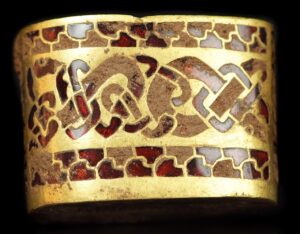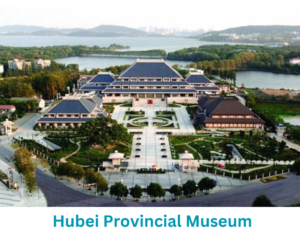Intro.
Occasionally there is an ancient find that seems to defy the amount of time it’s been hidden from the world. The Staffordshire Hoard immediately comes to mind. It’s an Anglo Saxon hoard of silver and gold, the biggest find ever recorded. Despite it being buried for about 1300 years and some of it bent out of shape it’s in pristine condition. This sword Hilt is among the nicest pieces, the Sword Of Goujian is similar in it’s rarity and beauty, perhaps it even surpasses the Staffordshire Hoard as it’s much older.

Part of a Sword Hilt found in the Staffordshire Hoard
Sword Of Goujian.
In October 1965 in Hubei Province, China a group of workers were digging along the side of the Zhang River Reservoir, Jinzhou in preparation for an aqueduct when they discovered a Tomb, in fact they discovered over 50 Tombs. For three months they focused on uncovering these Tombs. In total they found over 2000 artifacts tat were hidden from the light of day for over 2000 years.
In my view the most jaw dropping item found is The Sword Of Goujian.

Background.
Yue, also known as Yuyue was a province in ancient China. Today this province stretches across Zhejiang, Shanghai and Jiangsu. Back in the day the original Capitol Kuaiji, today known as Shaoxing.
Back in the 6th century the Yue people began fighting with it’s neighbors the Wu people. In short this was because the Yue rulers saw themselves as decedents of the mythical emperor Yu the Great and the Wu rulers didn’t like this idea because they believed they had the right to claim ruler-ship over all the other regional rulers, so a large punch up ensued that went on for several decades until the famous Yue King Goujian teamed up with the Chu people, enemies of the Wu rulers, and coordinated a smash and grab tactic and became owners of some new land. Some six generations later the Chu and Chi teamed up and forced the Yue rulers to back off and share the land, bringing about the fall of Yue in 306BC.
So the Yue people took off heading South and created another kingdom called Minue. It only lasted for 150 years when a fellow in a dog collar, well you know, the equivalent of, mobilized an army and punched the Han people into next week and grabbed the land back and restored the Yue kingdom.
Anyway, in the middle of all this fuss ‘The Sword of Goujian’ was made for the king. He must have done a great job to be presented with a sword like this.
What is the Sword made of?
It was found complete with a wooden scabbard covered in black lacquer. It had such a good fit around the blade and where the scabbard meets the handle that it was almost air tight. They believe this contributed to the lack of tarnish and overall damage, and this is despite the tomb being under water for well over 2 millennia.
Due to its lack of tarnish the University of Fudan and The Chinese Academy of Sciences studied the make up of elements. The make up of elements are Copper, Tin, Lead, Iron, Sulfur and Arsenic. Sulfur and Arsenic only show up in very small amounts. The Sword is is made predominantly from Copper and Tin. The edge has more tin content, probably in an effort to help keep an edge on it. Seeing as it was presented as a gift to the king, maybe only in his death to lie beside him in his journey to the after life it was probably never used. As you can see the blade has this repeating rhombus pattern in what we can describe as yellow color for the main body and a brown color ranging from light to dark for the rhombus pattern.
The handle is round and wrapped in silk, the pommel is a flat round disc with concentric circles.

The Ricasso area has Blue Turquoise stones shown here, it’s lost a few but we can see how it would have looked when it was first completed.

Who did it belong to?
As we move down the Sword we get to the area where the characters are written on the face of the blade. On one side of the blade up near the ricasso area are eight characters in an old text no-one uses today. Six of the characters are directed at the King of Yue (Goujian) “made this sword for personal use” and the other two are said to be naming “Goujian” as the “King of Yue”.
This king was a very determined kind of character. King Goujian had a sort of undying commitment the the prosperity of his kindon and keeping everyone safe. No matter how many defeats he may have had he stayed strong and refused to give in. Within himself he developed an attitude of endurance, no matter what the hardships are be stron and determined. His people followed along and supported him. I guess this is one of the reasons they made a blade such as The Sword of Goujian for him.
Specs.
- Sword Length: 55.6 cm (icluding the 8.4 cm handle)
- Blade Width: 4.6 cm wide at the base
- Weight: 875 grams
- Hanbdle Material: Wrapped in Silk
- Pommel: Round and Flat with 11 Concentric Circles



Where Can it be Seen.
These days you will have to go to China to see it. There was a time when it would go on display in different countries. However, in 1994 it was on loan in Singapore for a cultural exchange exhibition. During setting the display up some jug accidently banged it on the side of the transportation case and cracked the sword, just a small crack but damn, it’s still a crack. Since then China said, “no way hose” to any exhibition tours again.
The Sword of Goujian is currently housed in the Hubei Provincial Museum in Wuhan, Hubei Province, China

In my view this is one of the most interesting and important finds of the 20th century. I would love to travel there and see it for myself one day.
As always, happy camping :0)

